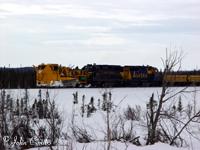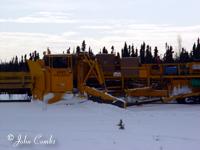Wednesday, March 10, 2004
To be in Talkeetna by 9:00 am, I had to crawl out of bed by
5:00 am. After a quick shower and breakfast, I was on the road north. The storms
had not affected the roads between Anchorage and Wasilla, but beyond that things
were pretty dicey.
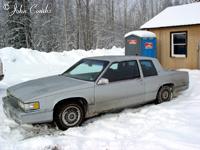 I
rolled into Talkeetna at 8:55 am, said a quick prayer of thanks for being able
to keep Don's gray 1989 Cadillac out of the ditches and found my crew, Frank
Armstrong, Duane "Do Anne" Frank, Rich "Hozer" Holzapfel,
Daryl "DK" Kollander and Derek "Rimfire" Winchester at the
Talkeetna section house. They spent some time getting their orders together
and making plans for the day. Their light-hearted banter and stories from the
previous evening would rival any comedy currently on television and portrayed
the camaraderie that existed between this crew. They developed a plan of action
and decided the best thing for me to do was to drive to Willow, get a ride back
north to Montana and catch the snow fleet there.
I
rolled into Talkeetna at 8:55 am, said a quick prayer of thanks for being able
to keep Don's gray 1989 Cadillac out of the ditches and found my crew, Frank
Armstrong, Duane "Do Anne" Frank, Rich "Hozer" Holzapfel,
Daryl "DK" Kollander and Derek "Rimfire" Winchester at the
Talkeetna section house. They spent some time getting their orders together
and making plans for the day. Their light-hearted banter and stories from the
previous evening would rival any comedy currently on television and portrayed
the camaraderie that existed between this crew. They developed a plan of action
and decided the best thing for me to do was to drive to Willow, get a ride back
north to Montana and catch the snow fleet there.
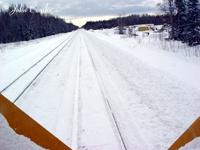 As
Rich Holzapfel and I waited for the fleet at the Montana grade crossing, we
swapped railroading stories. Within a half hour, the snow fleet came pounding
down the rails. The lineup was Jordan
spreader 9, GP40 numbers 3007 and 3012, several Difco dump cars, two flat
cars one of which held a company pickup truck and caboose 1081. With a great
deal of nervous excitement, I hopped aboard spreader 9. The work consisted of
clearing the sidings at Montana [click
here to view the 700KB video], Willow and Houston plus all grade crossings.
At each siding, the crew used the wings of the spreader to clear the mainline.
Conductor Duane Frank would then clean the snow from the switch points and align
the switch. The snow fleet would then enter the siding and use one of the wings
to push the rest of the snow off the siding. All snow removal was done at a
fairly slow speed so as to not risk derailing the spreader or rolling the rail.
As
Rich Holzapfel and I waited for the fleet at the Montana grade crossing, we
swapped railroading stories. Within a half hour, the snow fleet came pounding
down the rails. The lineup was Jordan
spreader 9, GP40 numbers 3007 and 3012, several Difco dump cars, two flat
cars one of which held a company pickup truck and caboose 1081. With a great
deal of nervous excitement, I hopped aboard spreader 9. The work consisted of
clearing the sidings at Montana [click
here to view the 700KB video], Willow and Houston plus all grade crossings.
At each siding, the crew used the wings of the spreader to clear the mainline.
Conductor Duane Frank would then clean the snow from the switch points and align
the switch. The snow fleet would then enter the siding and use one of the wings
to push the rest of the snow off the siding. All snow removal was done at a
fairly slow speed so as to not risk derailing the spreader or rolling the rail.
As the snow fleet traveled from siding to siding, they cranked
it up to a maximum of 35 miles per hour which produced a pronounced rocking
motion in the spreader. [click
here to view the 532KB video] Travel time was used to eat lunch or watch
for eagles and moose. Just when I thought it couldn't get any better than this,
the crew invited me to tag along with them tomorrow as they "went south"
to clear the snow from Portage to Grandview. Yowza!
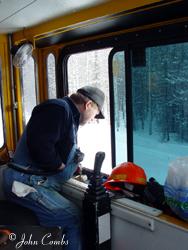 For
beginnings only: A Jordan spreader (first invented in 1900) is a very large
and complex piece of maintenance of way equipment. The spreader itself is pushed
with diesel locomotives which also supply the air required to operate them.
In the summer, it can be used to spread ballast (rock) along the rails. In the
winter, it can be used to plow snow. The front of the spreader has a large "V"
plow blade. This can be lowered to plow snow or raised to clear. The spreader
also has long blades (wings) on both sides that push snow clear of the tracks.
The height and width (spread) of each blade is controlled through hydraulics
by an operator using a joystick. One employee said the joystick found in Jordan
spreader 9 is based on the design of the one found in the F-15 Talon aircraft.
[click
here to view the 636KB video] Although the
Jordan spreader does a good job removing snow, the railroad prefers to use modified
ballast regulators which cost about one tenth the cost to operate.
For
beginnings only: A Jordan spreader (first invented in 1900) is a very large
and complex piece of maintenance of way equipment. The spreader itself is pushed
with diesel locomotives which also supply the air required to operate them.
In the summer, it can be used to spread ballast (rock) along the rails. In the
winter, it can be used to plow snow. The front of the spreader has a large "V"
plow blade. This can be lowered to plow snow or raised to clear. The spreader
also has long blades (wings) on both sides that push snow clear of the tracks.
The height and width (spread) of each blade is controlled through hydraulics
by an operator using a joystick. One employee said the joystick found in Jordan
spreader 9 is based on the design of the one found in the F-15 Talon aircraft.
[click
here to view the 636KB video] Although the
Jordan spreader does a good job removing snow, the railroad prefers to use modified
ballast regulators which cost about one tenth the cost to operate.
At Willow, the crew dropped Rich and I off near our cars. We
then headed to Houston to catch the snow fleet clearing the siding. I videotaped
the operation while Rich took photos with my digital camera. [click
here to view the 640KB video]
Returning to Anchorage, I washed Don's car at the Alaska Laser
Wash and filled it up with gas. Don had an extra special dinner prepared for
the three of us (his grandson Brian was also spending the night). We feasted
on spare ribs, rice, salad, sherbet and chocolate chip cookies. On the outside
of Don's door is a sign that says, "Here lives a spoiled rotten cat"
I think he should add "and ARR railfan" to the bottom of the sign.
Chapter 7 | Index
| Chapter 9
 I
rolled into Talkeetna at 8:55 am, said a quick prayer of thanks for being able
to keep Don's gray 1989 Cadillac out of the ditches and found my crew, Frank
Armstrong, Duane "Do Anne" Frank, Rich "Hozer" Holzapfel,
Daryl "DK" Kollander and Derek "Rimfire" Winchester at the
Talkeetna section house. They spent some time getting their orders together
and making plans for the day. Their light-hearted banter and stories from the
previous evening would rival any comedy currently on television and portrayed
the camaraderie that existed between this crew. They developed a plan of action
and decided the best thing for me to do was to drive to Willow, get a ride back
north to Montana and catch the snow fleet there.
I
rolled into Talkeetna at 8:55 am, said a quick prayer of thanks for being able
to keep Don's gray 1989 Cadillac out of the ditches and found my crew, Frank
Armstrong, Duane "Do Anne" Frank, Rich "Hozer" Holzapfel,
Daryl "DK" Kollander and Derek "Rimfire" Winchester at the
Talkeetna section house. They spent some time getting their orders together
and making plans for the day. Their light-hearted banter and stories from the
previous evening would rival any comedy currently on television and portrayed
the camaraderie that existed between this crew. They developed a plan of action
and decided the best thing for me to do was to drive to Willow, get a ride back
north to Montana and catch the snow fleet there. 

